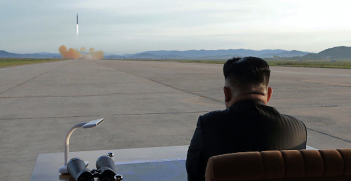The Implications of Withdrawal From Afghanistan
The announcement last week of the withdrawal all US, NATO and other allied (including Australian) forces from Afghanistan by 11 September this year represents the failure by all stakeholders to find a durable political solution within Afghanistan during the 20 years since the routing of the Taliban government following the 2001 terrorist attacks against the US.
Was Biden right or wrong to initiate the withdrawal, and end the ”forever war,” given the expectation the Taliban will exploit this to advantage? The answer is highly contestable. One view is Afghanistan needs more time to consolidate, to withdraw now amounts to abandonment. Another is the Afghans have wasted 20 years of opportunity, “Afghanistan fatigue” has set in, its time they fought their own war.
It is true that the initial US mission in 2001 was to attack Al Qaeda in Afghanistan to prevent it from further targeting the US homeland. It also successfully removed their host, the Taliban government, from power. Mission complete? Well, not quite.
Under strong US pressure, the above morphed into a UN-mandated political and economic nation-building project via the Bonn Agreement signed on 5 December 2001. Its aims were to “promote national reconciliation, lasting peace, stability …. respect for human rights” and “the right of the people …. to freely determine their own political future in accordance with the principles of Islam, democracy, pluralism and social justice.”
The Agreement also recommended the creation of an International Security Assistance Force (ISAF), which was subsequently created in late December via UN Security Council Resolution 1386. Its role was to establish Afghan military and security forces to “root out terrorism”, meet domestic “security and law and order”, and deter any further “threat to international peace and security.”
Both the Agreement and UNSCR 1386 included the specific proviso that “the responsibility for providing security and law and order throughout the country resides with the Afghans themselves.” The precursor to “Afghan owned, Afghan led.”
The political, legal, and administrative institutions of government were subsequently established at national and provincial levels. The Afghan National Defence and Security Force (ANDSF) was created with nation-wide missions and deployments. The UN and individual countries, through the UN or separately, contributed their expertise to the implementation of all programs and capabilities. As did the majority of Afghans directly involved. Programs included social and civil programs, especially women’s rights, health, education, agriculture, basic infrastructure, and governance, as well as military and police capabilities.
This report does not attempt to analyse in detail the challenges to and effectiveness of these programs – appropriate authorities and historians will do that. But in general, nation-building has failed to meet some key expectations.
Multiple sources have referred at various times to the lack of stabilization due to poor leadership at the national and provincial levels, to warlords and others ruthlessly pursuing personal rather than national agendas, and endemic corruption at all levels including within the electoral system, the judiciary and the administration generally. Aid programs, but especially local contracting, were also routine targets. Narcotics production and trafficking, and smuggling generally, was rife by both local government and the Taliban – sometimes in collusion with one-another.
In addition, attempts since the US-Taliban agreement in February 2020 to create national reconciliation through intra-Afghan peace talks, have also failed. The Taliban have shown no commitment other than to abstain from attacking US/NATO forces: their intent appears to be to increase leverage through increased violence against government and civilian targets. The government has also rejected the US-proposed shared interim government, wanting parliamentary power resolved through elections.
Several sources have stated that while the ANDSF’s special forces are highly competent, the regular army and police are not, despite years of training. The Taliban has targeted this vulnerability: ANDSF casualties were high, morale poor, and desertions a problem. The military especially, are still very dependent on US logistic and air support, and intelligence.
Despite the ANDSF’s manpower exceeding 300,000, the Taliban reportedly now control or have significant influence within about 60% of Afghanistan, mostly in rural areas. However, they are increasingly able to threaten larger towns including provincial capitals. And they can already conduct targeted bombings and assassinations in major towns, including Kabul. If the US airstrike capability is withdrawn, the Taliban’s ability to concentrate its forces will significantly threaten larger provincial towns and capitals.
What does this mean in terms of Bonn Agreement and UNSCR 1386 objectives? Collectively, national reconciliation, peace and stability still remain remote objectives. The dismal turnout at the 2019 presidential elections and the debacle afterwards about who won, also demonstrated that the Afghan government and politicians generally, at least currently, have little respect among the population. They are struggling to hold, let alone able to win more “hearts and minds” in areas under government control, and certainly unable to win them back in Taliban controlled areas.
It is also clear that the civil war, or “high intensity armed conflict,” cannot be won. Kabul formally assumed “Afghan owned and Afghan led” security responsibility in 2015, but simply remain unable to provide “security and law and order” throughout the country.
As Biden appreciated, there will never be an appropriate time to withdraw; to retain troops would simply perpetuate the “forever war.” As for the broken peace process, hand it over to the UN, and other regional countries, “especially Pakistan, as well as Russia, China, India and Turkey” – note Iran’s exclusion – to resolve.
As previously reported, the withdrawal will present multiple challenges to these regional stakeholders. While the UN may be able to ensure the 2001 Bonn Agreement objectives prevail, including women’s rights and education, within the larger towns and capitals, it remains to be seen whether they are retained as written and intended, in those mostly rural areas that become increasingly influenced by Afghanistan’s neighbours, especially in Taliban controlled areas adjacent to Pakistan.
While Biden’s decision can be explained, in part, as driven by continuing frustration and impatience with Afghanistan dating from his vice president days, notably he has not announced the withdrawal of US forces from either Iraq or Syria – at least yet. Why retain those forces but withdraw entirely from Afghanistan? And if the Taliban decide to attack US/NATO forces after the previously agreed withdrawal deadline of 1 May, would Biden reconsider total withdrawal?
Whether or not circumstances enable the US and other donors, including Australia, to deliver their aid commitments into the future as planned, remains to be seen. Whatever shape that future takes, there will certainly be a continuing need for aid.
In conclusion, two immediate likelihoods: firstly, further political turmoil as Afghanistan adjusts to the withdrawal; and secondly, a flood of Afghan refugees from amongst the urban educated who no longer have faith that the Bonn Agreement principles will be respected. Australia can expect to be one of the priority destinations for those refugees.
Ian Dudgeon is a presidential associate of the AIIA and a former ACT Branch president.
This article is published under a Creative Commons License and may be republished with attribution.





